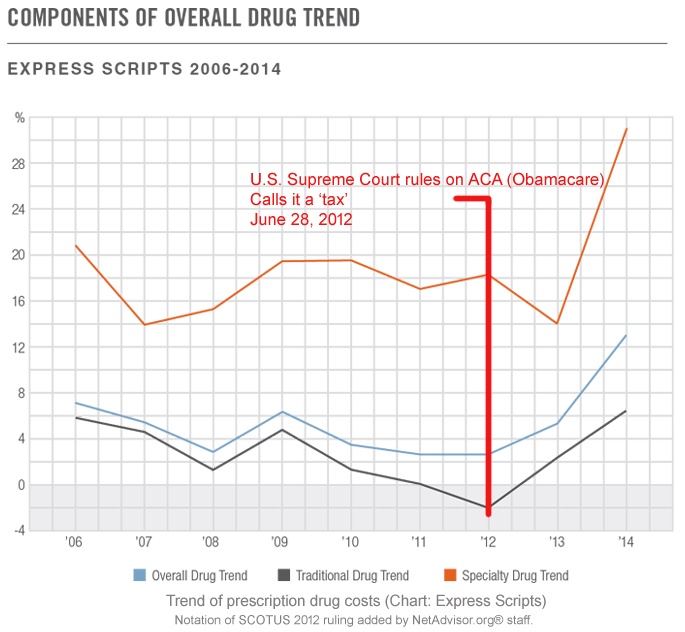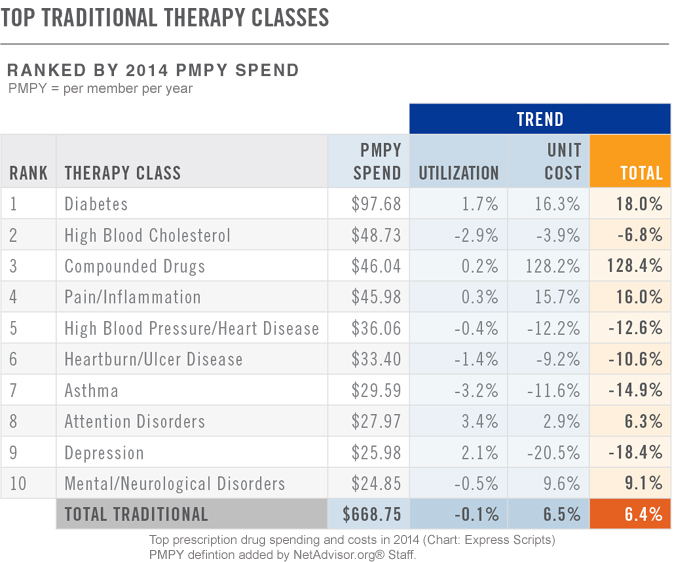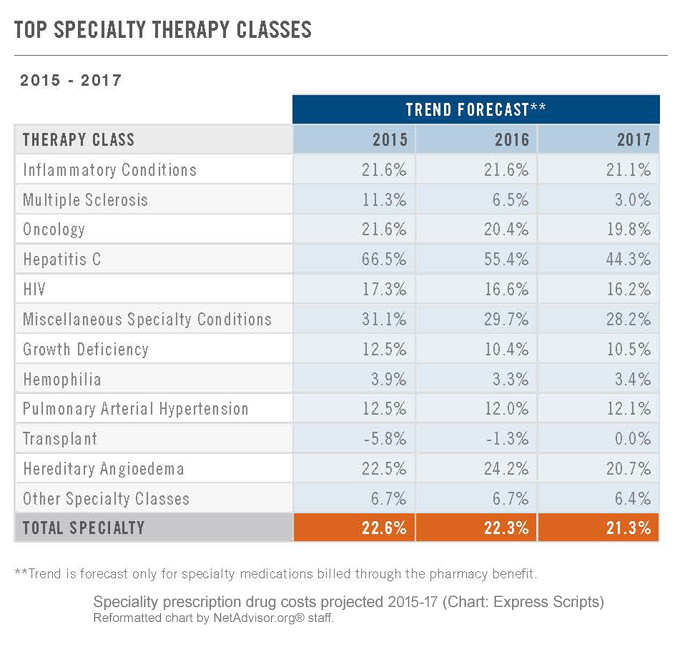April 19, 2015
Medicare Specialty Drug Costs up 45.9 Percent in 2014
original article written by Net Advisor™
WASHINGTON DC. Get ready for higher healthcare costs. The “Affordable” Care Act (“Obamacare”) is getting more expensive. Specialty prescription drug spending saw a whopping 45.9% increase in 2014.
In 2013, specialty prescription drugs saw an increase in costs by 14.7%. Commercial plans saw an increase by 30.9%. More than half of the cost increase came from the area of Hepatitis-C, Multiple Sclerosis and Oncology (cancer) drugs.
Hepatitis-C drugs saw the biggest jump in spending in 2013 with a 1,067.5% increase. Cancer drugs saw an average increase of 37.2%.
Express Scripts, a leading pharmacy benefit management services company found in this 2014 report (PDF) that the biggest cost in Medicare spending has to do with specialty prescription drugs. The report said the prescription drug spending (costs) are at the highest level since 2003.
[1] Health Care Drug Prices Going UP Under Obamacare
Since the passage of ObamaCare in 2010, government mandated new rules and regulations and someone has got to pay for all this. The chart at the top of this page shows that the costs of traditional, specialty and overall medical drugs costs have soared under ACA/ Obamacare.
The idea behind the “Affordable Care Act” implies that healthcare is supposed to be more ‘affordable.’ This is obviously not the case.
We now know that Pres. Obama’s lead architect of ObamaCare, Johnathon Gruber ADMITTED on Video that Obama’s healthcare law intended to deceive Americans.
[2] Who Pays for Health Care?
The wealthy have private insurance so they can afford the costs, and are not likely to be in government-ran programs. The poor have little money so they will need massive subsidies to help pay their costs. Younger people are generally not deemed a burden to the healthcare system, which is why the U.S. government wants young people to be enrolled on Obamacare. The government wants (needs) younger healthier people to finance those who are a greater burden to the healthcare system.
The middle-class is less likely to qualify for program subsides like the poor, so young people and middle-class families will end up paying the bulk of healthcare costs. Seniors may also see an increase in their healthcare costs.
[3] Top Therapies Project Costs Increases Over 21% Per Year From 2015-17
It is projected that top therapy drugs are expected to soar at the rate of over 21 percent per year for the next three years (chart below).
[4] Big ObamaCare Costs More Money
From 2006-2014 the number of people enrolled in Medicare Part-D (Gov. Prescription Drug Plan) is up 147% from 15 million (in 2006) to 22 million (in 2014) (p3).
The Kaiser Family Foundation said that in 2014 Medicare enrollments increased by 2 million to 37 million people. Medicare spending saw an average increase of 13.3% per person in 2013 and 0.5% in 2014.
When you add more people to a government healthcare system and then subsidize that system with taxpayer money, overall costs tend to go up, as all the graphics on this page show.
Healthcare premiums for Medicare Part-D have jumped 46% from 2006-2014 (p17). The report said that Part-D premiums have gone up about one percent (for stand-alone plans) since 2010. This was not due to any claim that the deficit is shrinking or that passing of ACA “Obamacare” had anything to do with this. It had to do with greater availability of generic drugs.
“A key factor driving slow premium growth in recent years is the availability of generic versions of many drugs used for common chronic conditions, which helps to limit growth in total plan costs and hence premiums.”
— Source: Kaiser Family Foundation (Report, p17).
Generic drugs are a direct result of expiring patents (PDF) where generic drug companies don’t have to spend billions of dollars (PDF) [and costs going higher (PDF)] and ten to fifteen years (Report, p2) of time doing research and trials to produce one drug, where the end result may or may not even work.
Thus the idea that healthcare costs, perception drug costs or the top therapies that people are using are becoming affordable under ObamaCare is just not supported by the data.
[5] The Uninsured: Impact Healthcare the Most
We also know that the uninsured impact healthcare costs the most. In 2013, I cited a U.S. government report that said five percent of the uninsured accounts for some 67.3 percent of all healthcare costs.
[6] Is Higher Healthcare Costs Impacting Job Growth?
The current healthcare system under Obamacare is reducing American jobs (report 1, report 2), and is not controlling the costs of healthcare. In Obama’s first four years as president, healthcare spending increased each year and exceeded $10 Trillion. Spending more money on healthcare has not created a healthier population.
“Spending a great deal on health care does not result in a healthier population. Of 34 OECD member countries, only three that spent the most per person have citizens that live the longest.
The United States spends more than any other country but only has the eighth-lowest life expectancy in the OECD.
Japan, meanwhile, spends $2,878 per person — about $5,000 less than the U.S. — and has the highest life expectancy among developed nations.”
[7] Part of a Solution to Healthcare Costs
I wrote an article 10 Things Congress Can Do to Reduce Heath Care Costs Now that provide strategies to help with healthcare costs. The plan does not involve higher taxes or more welfare spending. This plan creates competition, builds healthcare savings and potential wealth for generations for all Americans. That wealth creation helps future generations control their healthcare costs.
Unless Congress and the President decide to actually address the problems in healthcare instead of misleading us, the costs will likely continue to go up.
About the Author:
NetAdvisor™ previously held three insurance licenses (including healthcare) and six securities licenses including two in securities compliance and management oversight. Read more bio.
If you have enjoyed our reports, consider donating any amount to help fray the costs of operations. Please read more in the upper right column. Share this report on Facebook and Twitter. Thank you!
Original article content, Copyright © 2015 NetAdvisor.org® All Rights Reserved.
NetAdvisor.org® is a non-profit organization providing public education and analysis primarily on the U.S. financial markets, personal finance and analysis with a transparent look into U.S. public policy. We also perform and report on financial investigations to help protect the public interest. Read More.




